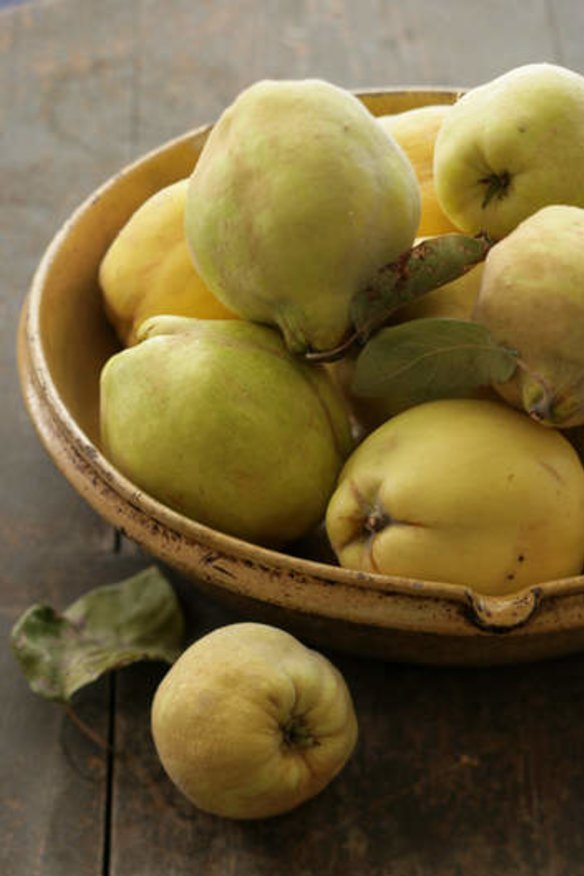Hardy quince truly versatile

The story about quinces begins in spring, when the delicate pink-and-white flowers appear on short shoots. One of the advantages in growing a quince tree is that it is self-fertile, so you do not need to plant a second variety to ensure that the flowers are cross pollinated. However, if you do grow several quince trees close together, it will promote better cropping overall.
Quinces grow well in ground that is too heavy for apples, so they are a good option for much of the Canberra region, where poor drainage is a common problem.
In summer, the quince tree does need to be watered regularly and deeply if the fruit is to grow to optimum size.
The quince tree is hardy and the fruit is hardy. Quinces came originally from Asia Minor, from the mountainsides of Iran and Armenia, then to Turkey and the Mediterranean countries.
The ancient Greeks certainly regarded them as a good symbol for love and fertility, using them in marriage ceremonies.
There are now cultivars from Portugal, Serbia, Turkey and France, as well as from North America and even Australia.
It takes six months for the fruit to ripen, but the wait is worth it. Quinces can be baked, stewed, poached and made into jam and jelly. Some turn a beautiful pink when cooked, while other varieties stay creamy yellow.
A quince tree can look quite straggly, with long, twisted branches. So as the tree grows, make sure that the centre of the tree is trimmed to allow light to penetrate. Long-established trees can grow to three or four metres and the branches that have carried this year's crop should be cut back. The large leaves provide good shade and they turn into a lovely autumnal yellow late in the season.
Look for golden fruit that is fully ripe to use in desserts. If you want to make jam or jelly, pick the fruit before it is fully ripe, because its pectin content will be highest at that stage.
Store the fruit in a cool, airy location, but avoid storing them next to apples or pears, because their strong scent will affect the other fruits.
Smyrna is probably the most well-known variety grown in Australia. Its fruit is quite large and the skin is lemony yellow. It ripens earlier than many other varieties. The De Vranja quince from Serbia matures early as well. It is a sweet quince, but the fruit has less pectin than most others.
The Fuller quince was developed in America in the 1860s. It matures early, is large, and has a lovely aromatic flavour. The Creswick apple-shaped quince from Victoria is an excellent Australian cultivar that produces good jelly and is delicious when stewed. The best late-maturing quince is probably the pineapple quince, so called because of its tropical aroma. It produces quality jelly and jam and is excellent when baked.
The Angers quince from central France is smaller, but the fruit cooks very well. This variety stores longer than most other quinces and the trees are very productive.
De Borgeaut is another good-quality quince, the juicy, yellow-coloured flesh of which is transformed into a deep colour on cooking. Similarly, the flesh of the orange quince turns deep red when cooked.
Veal steaks with quince sauce
1kg thick veal steaks
3 tbsp butter
2 tbsp quince jelly
pinch of nutmeg
1 tbsp parsley, chopped
1 tbsp chives, chopped
salt and pepper
Heat the butter in a deep frypan and cook the veal steaks on high heat. Remove the steaks from the pan, place on a warming plate and sprinkle lightly with salt and pepper. Add the quince jelly, nutmeg, parsley and chives to the liquids in the pan and stir well until the sauce begins to thicken.
Spoon the sauce over the steaks and serve with lightly cooked beans, broccoli and carrots.
This week in the garden
■ Begin to prepare a garden bed for planting garlic during the coming month. Add plenty of well-rotted compost and dig in well. Hill up the bed to provide adequate drainage.
■ Sow your first broad beans so that they will be well-established when the winter comes.
■ Sow some rows of broad beans to secure an early spring harvest. Plant also some rows of peas.
■ Harvest newly grown carrots as you need them. The remaining ones will then have more space to grow and will be available throughout winter.
>> Owen Pidgeon runs the Loriendale Organic Orchard near Hall.